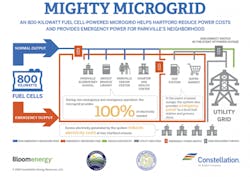Eight Projects Proposed in Round 4 of the Connecticut Microgrid Grant Program
The application window for Round 4 of the pioneering Connecticut microgrid grant program closed with the onset of the new year. Eight entities filed applications for funding to develop community microgrids with the Department of Energy and Environmental Protection (DEEP), which is managing and administering the program.
Originally created in 2012 upon passage of Public Act 12-148, Connecticut’s microgrid program was the first of its kind in the nation. Sponsored by the state, the program’s foremost goal is enhancing the reliability and resiliency of electricity supply.
All eight applicants proposed microgrids that will operate behind the utility meter. They also have black start and load shedding capabilities. Connected to the utility grid, the community microgrids will be able to disconnect from it and operate autonomously, in island mode, in the event of grid outages.
Connecticut microgrid grant program, Round 4
The eight, new grant applicants are:
- Fort Hill Farms, Fort Hill Ag-Grid: Agricultural/organic waste biogas
- Trinity College, Trustees of Trinity College: Natural gas fuel cells, solar PV, battery-based energy storage
- Town of Coventry, EcoSolar Installations: combined heat and power (CHP), solar PV, battery-based energy storage
- Bella Vista Apartment Towers, CT Energy & Technology: Natural gas-fueled CHP plant
- Borough of Naugatuck, Controlled Air: Natural gas-fueled CHP coupled with battery-based energy storage
- Westbrook Emergency Community Microgrid, USA Microgrids: Natural gas turbines, solar PV, battery-based energy storage
- Wesleyan University, AZCorp: Natural gas turbines, solar PV
- CMEEC (Connecticut Municipal Electric Energy Cooperative): Natural gas turbine, diesel generators, fuel cell
The Fort Hill Farms Microgrid
Fort Hill Ag-Grid Microgrid intends to deploy a Category 1, hurricane-hardened, 450-kW, low-carbon microgrid to supply 3.3 million kWh/year for lighting and operation of a diversified, family-owned dairy farm and a pet shelter in Thompson.
A projected 200,000 kWh/year will be consumed by the dairy farm, home to a herd of 200 dairy cows, which is expected to increase to 350 or more over the next five years.
The dairy farm will pay the microgrid project developers, a group that includes the chairman of Fort Hill Farms, $0.12/kWh, or a total of about $24,000 per year. The remaining 3.1 million kWh/yr is to be sold to the local grid operator at an estimated price of $0.13057/kWh.
The centerpiece of the Fort Hill Ag-Grid microgrid is an anaerobic biodigester that will convert the chemical energy in cow manure and organic waste from the farm and local community into electricity at a rate of more than 30 tons/day, or 13,000 tons/year.
In addition to being paid for electricity consumed by the dairy farm, project developers expect to earn revenues by collecting organic waste tipping fees, by selling surplus electricity to the utility grid, and by trading renewable energy credits (RECs).
Join us at Microgrid 2018 to hear more about microgrid funding offered by states.
Trinity College’s Microgrid
The Trinity College microgrid project features a 130-kW solar photovoltaic (PV) energy system, a 500-kW battery energy storage system and two fuel cells – one with 1,400 kWs of power production capacity from Connecticut-based FuelCell Energy and a second, 400-kW Doosan Purecell fuel cell. The microgrid is designed to supply power for the Trinity College’s central heating/cooling plant, Ferris Athletic Center, Koeppel Sports Community Center and Raether Library.
Plans call for installation, operation and maintenance of the fuel cells, solar PV, battery energy storage system, microgrid controller and associated infrastructure under 15-year power purchase agreements.
The Town of Coventry Microgrid
The Coventry microgrid will integrate existing and new electricity generation and distribution infrastructure to develop a microgrid that includes CHP, battery-based energy storage and solar PV.
CHP and solar PV, in conjunction with battery energy storage, will provide over 95 percent of power needs and reduce peak power demand for several customers, including the Orchard Hills community, Coventry High School/Middle School, local police and fire department buildings, school administration offices, the town hall and its annex and radio tower.
In the event of a grid outage, and the loss of solar PV, the CHP would provide power for all critical loads. The system also would provide battery energy storage for 4.5 hours of support for critical load in the absence of any other local generation resource. Combined, battery energy storage and solar PV, would supply up to 12 hours of critical load exclusive of CHP generation.
The community microgrid also will incorporate existing diesel or natural gas generators as emergency, back-up resources.
For details on other Round 4 applications see DEEP’s website.
First of its kind
Governor Dannel Malloy on July 24, 2013 announced the first awardees, which received $18 million for nine pilot projects. They were selected from a field of 36 applicants.
Public Act 13-298 authorized an additional $30 million in funding to expand the microgrid grant program over the ensuing two years. Community microgrid project developers that were not awarded funding in the pilot round were encouraged to apply for future funding.
Middletown, Connecticut became the first city in Connecticut to host a microgrid built through the program with the completion of Wesleyan University’s microgrid in March 2014. The university microgrid connects existing generation to critical facilities. When grid power is lost, the microgrid can island and autonomously power critical facilities.
A few months later, in October 2015, the Town of Fairfield’s commissioned a microgrid that serves the police headquarters, the city’s emergency communications center, a cell phone tower service, the fire department headquarters and a homeless shelter.
More recently, the City of Hartford joined with Constellation Energy and fuel cell developer Bloom Energy to deploy an 800-kW microgrid that features a natural gas-fueled, Bloom Energy fuel cell. Developers of the Hartford community microgrid received a microgrid grant of about $2 million to see the project through to fruition.
Planning to speak at Microgrid 2018? The deadline for proposals is soon! Submit your proposal here.
